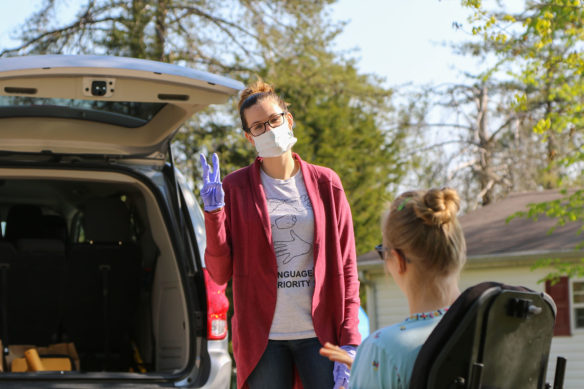
Kentucky School for the Deaf history teacher Kelsey Grievson, left, signs with Georgia Bell Judge, a student at KSD. Beginning April 20, staff from the Kentucky School for the Blind and the Kentucky School for the Deaf began personally delivering NTI packets to their students.
Photo by Jacob Perkins, April 20, 2020
- Beginning April 20, staff from the Kentucky School for the Blind and the Kentucky School for the Deaf began personally delivering NTI packets to their students.
- While there is no substitute for in-person classes, KSD Guidance Counselor Stuart Harper said that most of KSD’s students have done a good job of adapting to NTI.
By Jacob Perkins
Jacob.perkins@education.ky.gov
For the time being, distance learning has become the new normal in Kentucky public education.
Students, educators and school staff have traded in traditional classroom settings for kitchen tables and living rooms. They’ve traded in co-workers and classmates for pets, siblings and other family members.
While this is a trying time for all of Kentucky’s education family, this isolation is amplified for the students from the Kentucky School for the Deaf (KSD) and the Kentucky School for the Blind (KSB) – residential schools operated by the Kentucky Department of Education.
“Our students are in a unique situation,” said KSD Guidance Counselor Stuart Harper. “Being Deaf or Hard of Hearing often means a very limited group of people to communicate with.”
When the students of KSD and KSB are on campus, there are little to no communication barriers. When they head home, that’s not always the case.
“Now that students are basically quarantined at home, they see only family members all day long,” said Harper. “Some families can communicate great in ASL (American Sign Language), while other families may be quite limited in their ASL ability.”
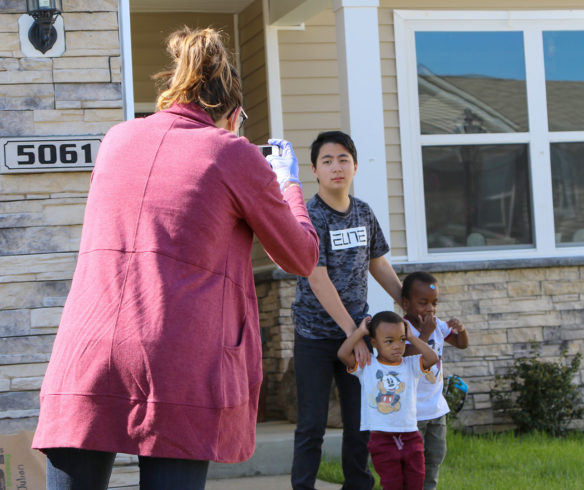
Kentucky School for the Deaf Teacher Kelsey Grievson, left, takes a photo of KSD student Julian Zareen, center. As KSB and KSD are residential schools, students typically would spend five days on campus and then head back home on the weekends.
Photo by Jacob Perkins, April 20, 2020
All 172 Kentucky school districts, 53 area technology centers, KSB and KSD ceased in-person classes and began instituting KDE’s Non-Traditional Instruction Program (NTI) in response to a March 16 recommendation made by Gov. Andy Beshear.
Before schools closed, KSD Principal Toyah Robey instructed her teachers to prepare educational materials for the students in the form of NTI packets. The initial packet was sent home with students on the last day of school, with a second packet sent out a few weeks later.
Beginning April 20, KSD and KSB staff set out with ample masks and gloves to personally deliver the third round of NTI packets to their students. While it was difficult, those involved enforced the recommended minimum of six feet of social distancing.
“I’m a hands-on teacher,” explained Connie Hill, a low-vision instructor at KSB. “The hardest part is that I can’t go and hug the kids. It takes away the personal part of being a teacher; giving the extra attention that they need.”
Harper said that the interaction between KSD’s staff and students is especially vital as the students navigate through this time.
“It gives them that emotional lift of seeing friends who support them, who can encourage them to keep their spirits up and keep working hard on their assignments,” he said.
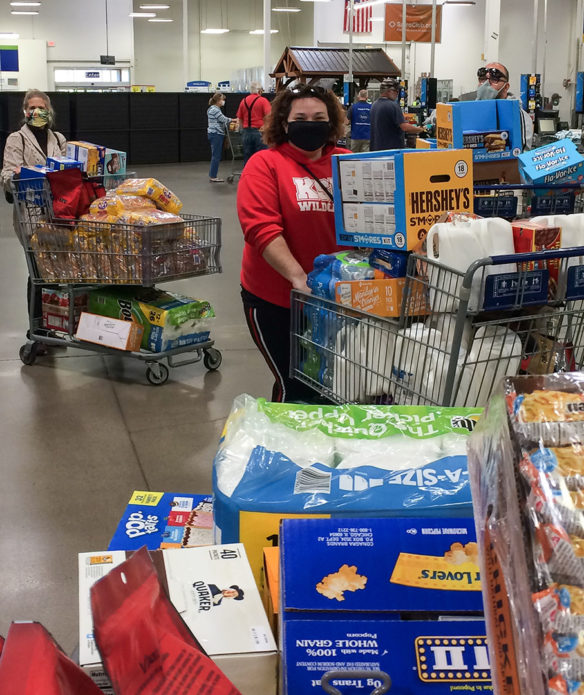
Kentucky School for the Blind (KSB) Charitable Foundation volunteers and KSB staff shopped and packed up groceries for 24 families across Kentucky. Connie Hill, a low-vision instructor at KSB, helped distribute the food.
Photos submitted
According to both Hill and Harper, this third set of assignments and materials puts a stronger emphasis on virtual learning. Staff from each school will be delivering large packets of NTI materials and laptops to the school’s middle and elementary students to ensure technological access.
“The teachers at KSD quickly established schedules when their classes meet online and students and staff can see each other and communicate via video,” Harper explained. “Students can ask questions in real time with their teachers and peers, and teachers can give new assignments and actually teach. Students are also free to contact their teachers and staff at any time to ask questions and receive individual assistance one-on-one.”
While there is no substitute for in-person classes, Harper said that most of KSD’s students have done a good job of adapting to NTI.
“Probably like most schools, we do have a few students who struggle with the new format,” he said. “In these cases, the teachers and staff make a special effort to communicate daily to encourage students and provide additional support. Parents are also contacted to keep them informed of progress and to give suggestions for how to help their child at home.”
Hill agrees that including parents in communication, especially for KSB’s families that may not be able to read braille, is a necessity.
“It’s very important to have communication with the parent because the parent is very vital,” she said. “They need to know what’s going on because right now … a lot of people have a fear because they don’t know when this is going to end. We just need that contact.”
As KSB and KSD are residential schools, students typically would spend five days on campus and then head back home on the weekends. This means that the teachers and staff at the school form a special bond with each of the students on campus.
“Like all teachers in Kentucky, we grow close to our students during the school year,” said Harper. “It has been very challenging to do the work of teaching but be unable to have that physical interaction with the students. Teachers and staff need those personal connections, as well as the students, and these trips will enable some of us to reconnect with students.”
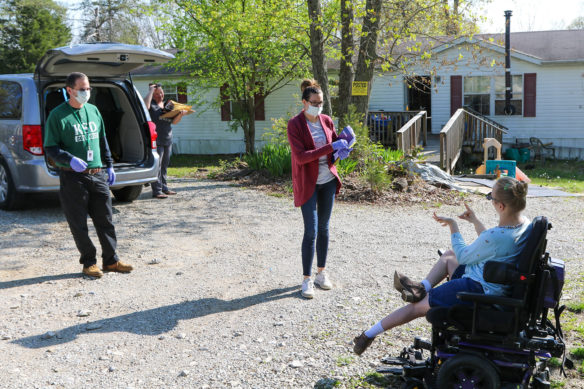
Kentucky School for the Deaf (KSD) Counselor Stuart Harper, from left, and KSD history teacher Kelsey Grievson deliver NTI materials to KSD student Georgia Bell Judge. Those involved enforced the recommended minimum of six feet of social distancing.
Photo by Jacob Perkins, April 20, 2020
For teachers across Kentucky, this time of NTI has been both challenging and rewarding.
“You really have to think outside of the box and be really creative with your teaching,” said Hill. “It’s a different form of teaching that we’ve never done before. It’s like anything else, you have to figure out what’s working and what’s not working and then you take it from there.”
The creativity that comes with NTI is something that Harper already has witnessed at KSD. Teachers at the school have been sharing resources and consulting with one another to discover successful ways to deliver instruction.
“It can be difficult for teachers to revise their lesson plans and activities, but at the same time we have seen remarkable effort and creativity,” said Harper. “To see the collaboration and care that the teachers are putting into their activities is truly inspiring, even to someone like me who has been here for almost 20 years. It makes me proud to be a part of this team.”
For more information about COVID-19:
- Kentucky Department for Public Health’s COVID-19 webpage
- KDE’s COVID-19 webpage
- COVID-19 Hotline (800) 722-5725


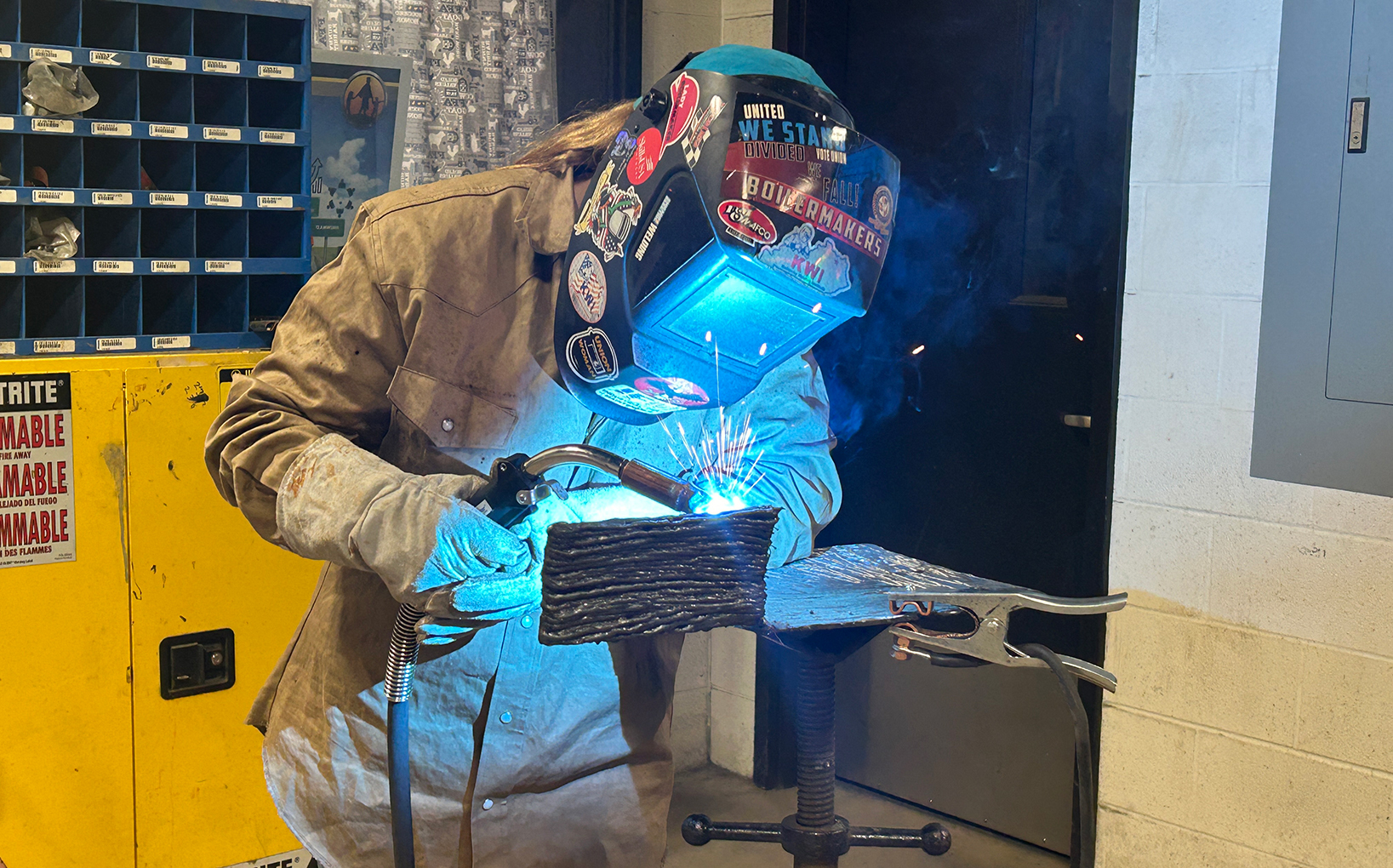
Leave A Comment